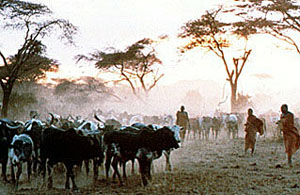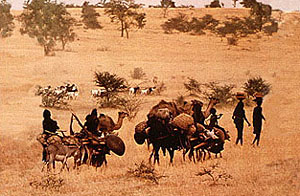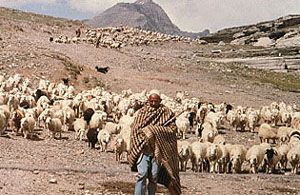 Ten to twelve thousand years ago, at approximately the same time that agriculture emerged out of hunting and gathering, a parallel specialization appeared: pastoralism, the herding of domesticated or partially domesticated animals.
Ten to twelve thousand years ago, at approximately the same time that agriculture emerged out of hunting and gathering, a parallel specialization appeared: pastoralism, the herding of domesticated or partially domesticated animals.Pastoralism has much more in common culturally with hunting and gathering styles of life than with sedentary agriculture. The necessity to move the herds continually in search of fresh pastures makes this a wandering, nomadic way of life. Human and livestock populations tended to wax and wane according to the vagaries of the weather--rainfall and availability of grass. While pastoral life is demanding and often dangerous, it is, as a way of life, relatively stable over long periods of time, like hunting and gathering. What one generation knew and did, the next generation knew and did.
 Pastoralism tended to develop on marginal land apart from areas suitable for agriculture, often in semi-arid regions. Frequently, the two ways of life, pastoralism and agriculture, were compatible, or even mutually dependent. Wherever the two modes of life existed near one another, a lively trade usually sprang up between farmers who had grain, metal and fabricated objects to exchange, and pastoral nomads, who had hides, wool, meat, and milk products.
Pastoralism tended to develop on marginal land apart from areas suitable for agriculture, often in semi-arid regions. Frequently, the two ways of life, pastoralism and agriculture, were compatible, or even mutually dependent. Wherever the two modes of life existed near one another, a lively trade usually sprang up between farmers who had grain, metal and fabricated objects to exchange, and pastoral nomads, who had hides, wool, meat, and milk products.
 Other ways of interacting emerged as well: with their greater mobility, pastoral nomads have frequently found raiding of settled agricultural lands tempting and profitable. And with their constantly increasing populations, agriculturalists have tended to encroach on any land that can be converted to the growing of crops. In other words, with these two specializations, organized warfare emerged and became common.
Other ways of interacting emerged as well: with their greater mobility, pastoral nomads have frequently found raiding of settled agricultural lands tempting and profitable. And with their constantly increasing populations, agriculturalists have tended to encroach on any land that can be converted to the growing of crops. In other words, with these two specializations, organized warfare emerged and became common.